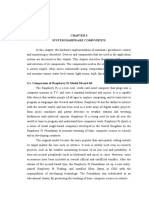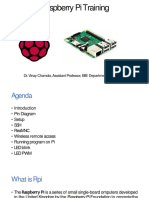Raspberry Pi
Uploaded by
VIGNESH V 20EER100Raspberry Pi
Uploaded by
VIGNESH V 20EER100Embedded system and IoT
Unit- V : Design and Development
RASPBERRY PI – Board details
PRAVEENKUMAR K
20EER074
Aug 28, 2021
RASPBERRY PI
INTRODUCTION
Raspberry Pi is a series of compact, single-board computers developed by the
Raspberry Pi Foundation, a charitable organization based in the United Kingdom.
These small yet powerful computers are designed to facilitate learning,
experimentation, and prototyping in the realm of computer science and
electronics. Raspberry Pi boards consist of a central processing unit (CPU),
memory (RAM), input/output interfaces, and general-purpose input/output
(GPIO) pins, all integrated onto a single circuit board.
RASPBERRY PI
Aug 28, 2021
1/59
RASPBERRY PI
OPERATING SYSTEM(OS)
Raspberry Pi supports various operating systems (OS) that cater to different needs and
preferences.
Raspberry Pi OS (formerly Raspbian): Raspberry Pi OS is the official operating
system for Raspberry Pi. It comes with a wide range of pre-installed software and tools,
making it ideal for beginners.
Windows 10 IoT Core: Windows 10 IoT Core is a version of Windows 10 designed for
small, low-cost devices that can run Universal Windows Platform (UWP)
applications.
Ubuntu: There is an official version of Ubuntu called "Ubuntu Desktop for Raspberry
Pi" which provides a full desktop experience. It is based on Ubuntu Linux and supports
many standard Ubuntu applications.
Aug 28, 2021
1/59
RASPBERRY PI
COMPONENTS
Central Processing Unit (CPU): Every computer has a Central Processing Unit,
and so does the Raspberry Pi. It is the computer’s brain and carries out
instructions using logical and mathematical operations. Raspberry Pi makes use
of the ARM11 series processor on its boards.
HDMI port : Raspberry Pi board has an HDMI or High Definition Multimedia
Interface port that allows the device to have video options of the output from the
computer displayed.
Graphic Processing Unit (GPU): This unit, GPU or Graphic Processing Unit, is
another part of the Raspberry pi board. Its primary purpose is to hasten the speed
of image calculations.
RASPBERRY PI
Memory (RAM): Random Access Memory is a core part of a computer’s processing
system. It is where real-time information is stored for easy access. The initial
Raspberry Pi had 256MB RAM. The model with the maximum capacity presently is
the Raspberry Pi 4 with 8GB RAM space.
Ethernet port: The Ethernet port is a connectivity hardware feature available on B
models of Raspberry Pi. The Ethernet port enables wired internet access to the
minicomputer. Without it, software updates, web surfing, etc., would not be possible
using the Raspberry Pi. The Ethernet port found on Raspberry computers uses the
RJ45 Ethernet jack. With this component, Raspberry Pi can connect to routers and
other devices.
Aug 28, 2021
1/59
RASPBERRY PI
SD card slot: The Raspberry Pi board has a Secure Digital card or SD card slot
where users must insert SD cards for the computer to function. The SD card
functions like a hard drive as it contains the operating system necessary for turning
the system on. It also serves to store data.
General Purpose Input and Output (GPIO) pins: GPIO pins are used to
interact with other electronic circuits. They can read and control the electric signals
from other boards or devices based on how the user programs them. The oldest
models of the Raspberry Pi had 26 pins, but most have 40 GPIO pins.
Aug 28, 2021
1/59
RASPBERRY PI
LEDs
These are a group of five light-emitting diodes. They signal the user on the present
status of the Raspberry Pi unit. Their function covers:
• PWR (Red): This functions solely to indicate power status. When the unit is on, it
emits a red light and only goes off when the unit is switched off, or disconnected
from the power source.
• ACT (Green): This flashes to indicate any form of SD card activity.
• LNK (Orange): LNK LED gives off an orange light to signify that active
Ethernet connectivity has been established.
• 100 (Orange): This light comes on during Ethernet connection when the data
speed reaches 100Mbps.
• FDX (Orange): FDX light also comes during Ethernet connection. It shows that
the connection is a full-duplex.
Aug 28, 2021
1/59
RASPBERRY PI
USB ports : Universal service bus (USB) ports are a principal part of Raspberry
Pi. They allow the computer to connect to a keyboard, mouse, hard drives, etc.
The first model of Raspberry Pi had only two USB 2.0 ports. Subsequent models
increased this number to four. Raspberry Pi 4 and Pi 400, much newer models,
come with a mix of USB 2.0 and USB 3.0 ports.
Power source: Raspberry Pi has a power source connector that typically uses a 5V
micro USB power cable. The amount of electricity any Raspberry Pi consumes
depends on what it’s used for and the number of peripheral hardware devices
connected.
Aug 28, 2021
1/59
RASPBERRY PI
DIFFERENT BOARDS
• Pi 1 Model B: Released in 2012
• Pi 1 Model A: Released in 2013
• Pi 1 Model B+: Released in 2014
• Pi 1 Model A+: Released in 2014
• Pi 2 Model B: Released in 2015
• Pi Zero: Released in 2015
• Pi 3 Model B: Released in 2016
• Pi Zero W: Released in 2017
• Raspberry Pi 400: Released in 2020
RASPBERRY PI
PROGRAMMING LANGUAGE
• Programming an raspberry pi involves the writing code, typically in the C/C+
+,python,scratch .
• Some other languages are java,javascript.
RASPBERRY PI
FEATUERS
• Compact Size: Raspberry Pi boards are small and compact, making them
suitable for projects with space constraints.
• Broadcom Processor: Raspberry Pi typically uses ARM-based processors
from Broadcom, which provide a good balance of performance and energy
efficiency.
• Video Output: Raspberry Pi boards usually have HDMI or composite video
output, enabling them to connect to monitors and TVs.
• Network Connectivity: Raspberry Pi boards often have built-in Ethernet ports
and support for Wi-Fi and Bluetooth connectivity, allowing them to connect to
networks and other devices wirelessly.
RASPBERRY PI
FEATUERS
• Operating System Support: Raspberry Pi supports various operating systems,
including Raspbian (a Debian-based Linux distribution optimized for Raspberry
Pi), as well as other Linux distributions and even Windows 10 IoT Core.
• Camera Interface: Raspberry Pi models often feature a camera interface,
allowing users to connect camera modules and capture photos and videos.
• Display Interface: In addition to HDMI output, Raspberry Pi boards may feature
display interfaces like DSI (Display Serial Interface) and MIPI DSI for connecting
to compatible displays.
• Audio Output: Raspberry Pi has a 3.5mm audio jack for connecting speakers or
headphones, enabling audio output for multimedia applications.
Aug 28, 2021
1/59
ARDUINO
ADVANTAGES
• Affordability: Raspberry Pi boards are affordable, making them accessible to a
wide range of users, including students, hobbyists, and educators. The low cost
encourages experimentation and learning without a significant financial
investment.
• GPIO Pins: Raspberry Pi boards come with General Purpose Input/Output
(GPIO) pins, allowing users to connect various sensors, actuators, and other
electronic components. This feature is essential for hardware projects and
experiments.
• Compact Size: The small size of Raspberry Pi boards makes them suitable for
projects with limited space, including portable devices and embedded systems.
• Low Power Consumption: Raspberry Pi boards are energy-efficient, consuming
very little power compared to traditional desktop computers. This makes them
suitable for battery-powered projects and continuous operation without a
significant impact on electricity bills.
• Easy Setup: Raspberry Pi boards are designed for easy setup. They typically run
on microSD cards, and users can choose from various operating systems, making
it straightforward to customize the Pi for specific applications.
ARDUINO
DISADVANTAGES
• Limited Processing Power: Raspberry Pi boards are not as powerful as high-
end desktop computers or servers. While they are suitable for many tasks, they
can struggle with resource-intensive applications or tasks that require significant
computational power.
• Limited RAM: Raspberry Pi models typically come with limited RAM, which
can affect the performance of applications, especially when running multiple
programs simultaneously or dealing with large datasets.
• Limited Graphics Capabilities: Raspberry Pi's graphic capabilities might not
be sufficient for demanding graphical applications or modern video games.
• Limited Storage: Raspberry Pi primarily uses microSD cards for storage. While
you can use external storage options, the default microSD card storage can be
limited in terms of speed and capacity.
You might also like
- NCTU PPT 2023-2024 - WEEK3-Raspberry PiNo ratings yetNCTU PPT 2023-2024 - WEEK3-Raspberry Pi25 pages
- Types of Raspberry PI - Campus ComponentNo ratings yetTypes of Raspberry PI - Campus Component4 pages
- A Review Paper On Raspberry Pi and Its ApplicationsNo ratings yetA Review Paper On Raspberry Pi and Its Applications3 pages
- IAETSD-The Universal Brain For All RobotsNo ratings yetIAETSD-The Universal Brain For All Robots8 pages
- Raspberry Pi: Raspberry Pi programming for beginners, including Raspberry Pi projects, tips, tricks, and more!From EverandRaspberry Pi: Raspberry Pi programming for beginners, including Raspberry Pi projects, tips, tricks, and more!No ratings yet
- Shaikh Mariyam TYIT-B (83) IOT Practical FileNo ratings yetShaikh Mariyam TYIT-B (83) IOT Practical File159 pages
- Portable and Inexpensive Computing With Raspberry PiNo ratings yetPortable and Inexpensive Computing With Raspberry Pi8 pages
- Raspberry Pi Pages From Computer Shopper 2015-02No ratings yetRaspberry Pi Pages From Computer Shopper 2015-0216 pages
- Voice Control Home Automation Using Raspberry PI With Code.No ratings yetVoice Control Home Automation Using Raspberry PI With Code.29 pages
- Raspberry Pi BSC IT manual latest updatedNo ratings yetRaspberry Pi BSC IT manual latest updated78 pages
- Python Programming Characteristics: Raspberry Pi Board TechnologyNo ratings yetPython Programming Characteristics: Raspberry Pi Board Technology4 pages
- What Are The Similarities and Differences of The Raspberry Pi Pico VariantsNo ratings yetWhat Are The Similarities and Differences of The Raspberry Pi Pico Variants8 pages
- Raspberry Pi & Arduino: What Makes Them Awesome!!!: Prepared By: Rukhiyah AdnanNo ratings yetRaspberry Pi & Arduino: What Makes Them Awesome!!!: Prepared By: Rukhiyah Adnan3 pages
- DS-400 Semi-Auto Chemistry Analyzer CatalogNo ratings yetDS-400 Semi-Auto Chemistry Analyzer Catalog1 page
- Multi-Core Computing: Mohammad Tarik M Husam ShakiarNo ratings yetMulti-Core Computing: Mohammad Tarik M Husam Shakiar27 pages
- Fujitsu Siemens Lifebook T4220 - User GuideNo ratings yetFujitsu Siemens Lifebook T4220 - User Guide136 pages
- Factors Influencing The Laptop Buying Behaviour of Students in VietnamNo ratings yetFactors Influencing The Laptop Buying Behaviour of Students in Vietnam3 pages
- All Rights Reserved. Equipment Subject To Change Without Notice: Page 1 of 2 Hima Paul Hildebrandt GMBH, P.O. Box 1261, 68777 BrühlNo ratings yetAll Rights Reserved. Equipment Subject To Change Without Notice: Page 1 of 2 Hima Paul Hildebrandt GMBH, P.O. Box 1261, 68777 Brühl2 pages
- 8051 Programming For UART: Serial - InitNo ratings yet8051 Programming For UART: Serial - Init5 pages
- Workstation Player 16 Windows User GuideNo ratings yetWorkstation Player 16 Windows User Guide177 pages
- Evolution of Supercomputers - by Tanish Ghatge 9th ANo ratings yetEvolution of Supercomputers - by Tanish Ghatge 9th A11 pages
- Loosely Coupled Architecture-Kmap, Intercluster and Intracluster CommunicationNo ratings yetLoosely Coupled Architecture-Kmap, Intercluster and Intracluster Communication10 pages
- Raspberry Pi: A Beginner's Guide to Raspberry Pi ProgrammingFrom EverandRaspberry Pi: A Beginner's Guide to Raspberry Pi Programming
- A Review Paper On Raspberry Pi and Its ApplicationsA Review Paper On Raspberry Pi and Its Applications
- Raspberry Pi: Raspberry Pi programming for beginners, including Raspberry Pi projects, tips, tricks, and more!From EverandRaspberry Pi: Raspberry Pi programming for beginners, including Raspberry Pi projects, tips, tricks, and more!
- Portable and Inexpensive Computing With Raspberry PiPortable and Inexpensive Computing With Raspberry Pi
- Voice Control Home Automation Using Raspberry PI With Code.Voice Control Home Automation Using Raspberry PI With Code.
- Python Programming Characteristics: Raspberry Pi Board TechnologyPython Programming Characteristics: Raspberry Pi Board Technology
- What Are The Similarities and Differences of The Raspberry Pi Pico VariantsWhat Are The Similarities and Differences of The Raspberry Pi Pico Variants
- Raspberry Pi & Arduino: What Makes Them Awesome!!!: Prepared By: Rukhiyah AdnanRaspberry Pi & Arduino: What Makes Them Awesome!!!: Prepared By: Rukhiyah Adnan
- Multi-Core Computing: Mohammad Tarik M Husam ShakiarMulti-Core Computing: Mohammad Tarik M Husam Shakiar
- Factors Influencing The Laptop Buying Behaviour of Students in VietnamFactors Influencing The Laptop Buying Behaviour of Students in Vietnam
- All Rights Reserved. Equipment Subject To Change Without Notice: Page 1 of 2 Hima Paul Hildebrandt GMBH, P.O. Box 1261, 68777 BrühlAll Rights Reserved. Equipment Subject To Change Without Notice: Page 1 of 2 Hima Paul Hildebrandt GMBH, P.O. Box 1261, 68777 Brühl
- Evolution of Supercomputers - by Tanish Ghatge 9th AEvolution of Supercomputers - by Tanish Ghatge 9th A
- Loosely Coupled Architecture-Kmap, Intercluster and Intracluster CommunicationLoosely Coupled Architecture-Kmap, Intercluster and Intracluster Communication





























































































